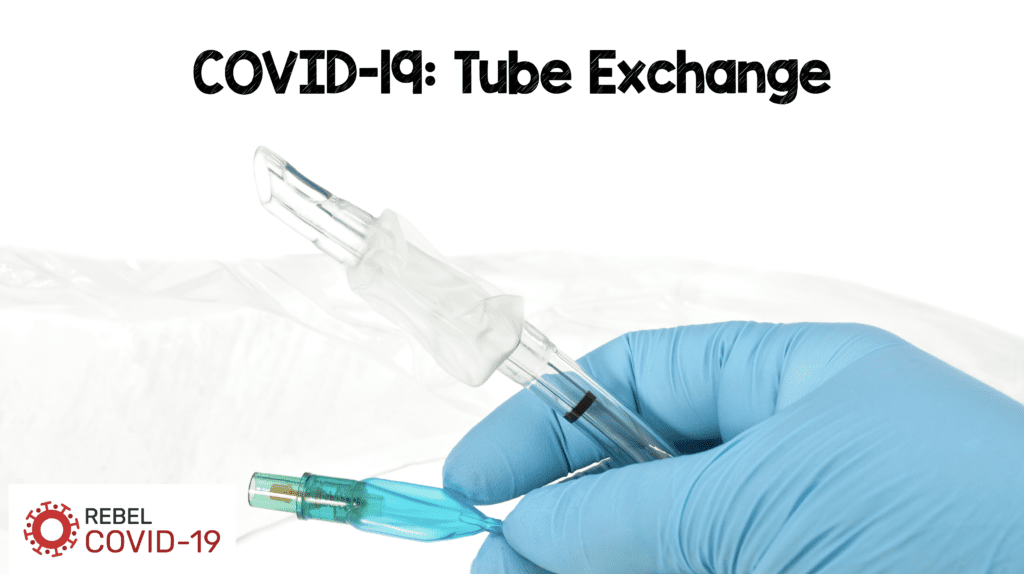
 Introduction: Emergency physicians rarely are involved in tube exchanges; I can’t remember the last time I had to do one. However, during the COVID19 surge, we found ourselves boarding intubated patients for days and even weeks as our ICUs were filled to the brim. With our ICU teams so busy, it became increasingly important for us to aid in critical care management where we could. Initially this was simply with lines and hemodynamic monitoring but, tube exchange became important. A number of our boarding patients developed considerable mucous plugging and tube obstruction that could not be cleared by suction. Reintubation with a fresh tube, while well within our scope, creates unnecessary risks – aerosol generation, increased provider exposure and possible harm to patient if intubation proves challenging. Tube exchange over a bougie seems to make a lot of sense.
Introduction: Emergency physicians rarely are involved in tube exchanges; I can’t remember the last time I had to do one. However, during the COVID19 surge, we found ourselves boarding intubated patients for days and even weeks as our ICUs were filled to the brim. With our ICU teams so busy, it became increasingly important for us to aid in critical care management where we could. Initially this was simply with lines and hemodynamic monitoring but, tube exchange became important. A number of our boarding patients developed considerable mucous plugging and tube obstruction that could not be cleared by suction. Reintubation with a fresh tube, while well within our scope, creates unnecessary risks – aerosol generation, increased provider exposure and possible harm to patient if intubation proves challenging. Tube exchange over a bougie seems to make a lot of sense.
Note: Due to the lack of experience most EM clinicians have with this procedure and the fact that it is a high-risk one, it may be best to consult anesthesia to help with the procedure if they are available. We acknowledge that this may not be possible if that service is stretched thin due to circumstances.
Requirements of Procedure:
- Simple with equipment commonly found in EDs
- Rapid tube exchange
- Minimal provider exposure
Preparation:
1. Gather equipment
- Video laryngoscope
- Gum elastic bougie
- ETT of same size and size smaller
- Suction setup
- Paralytic (ideally rocuronium)
- BVM
- End Tidal CO2
2. Don airborne + contact PPE
3. Minimal staff in room: Airway provider + respiratory therapist
Tube Exchange Process:
- Ensure patient with adequate sedation and analgesia
-
Deliver paralytic
- Consider deep paralysis due to avoiding potential for gag, cough + aerosol generation
- Rocuronium 1.2 mg/kg + wait for it to take effect (rocuronium minimum 60 seconds)
- Place bite block or oral airway (after paralysis complete)
- Lubricate bougie
-
Place laryngoscope blade into airway
- Have second person hold laryngoscope in place so you have both hands for tube exchange
- Alternatively, you can hold laryngoscope in place and have assistant perform exchange
- Clear any secretions with suction catheter and then place catheter to left of ETT + park (will continue to clear any aerosolized particles)
- Detach ETT from securing device
- Place bougie into tube until hold up felt
- Deflate ETT balloon, remove ETT over bougie and place fresh ETT over bougie under visualization
- Attach viral filter, confirms with EtCO2, attach vent and resecure ETT
Note: If you have experience and access to a dedicated tube exchange device, we strongly recommend using one. This post was built without these in mind as most EDs do not have access to them.
Post Peer-Reviewed By: Haney Mallemat, MD (@CriticalCareNow)
The post COVID-19: Tube Exchange appeared first on REBEL EM - Emergency Medicine Blog.
